
Let’s face it — February, March and April can be gray and dreary months. You’re more than ready for spring to begin, but Mother Nature is on a different schedule. But you can jump start the season of growth early and bring it inside where you can enjoy it through those last moments of winter.
Stale, polluted air happens frequently when homes are closed up for the winter months. But houseplants help to lighten the mood and purify the air. A NASA study found that houseplants remove up to 87 percent of toxic indoor air inside a sealed chamber within 24 hours.
Start your spring season early by planting vegetables, herbs and flowers while winter is still in the air, so they’ll be primed for transplanting when the spring season actually arrives. You can watch the plants as they shoot their little green stems out of the fresh dirt, monitoring them as they grow larger and larger.
* Use loose potting soil to promote root growth. Outside, worms and insects tunnel through the dirt, naturally breaking it up to help plants spread their roots. To mimic their effect indoors, use potting soil mixed with peat moss, vermiculite and perlite to create a light texture that won’t compact after a couple of waterings.
* Keep the humidity level above 50 percent with a humidifier. Not only will your plants appreciate the extra moisture, but so will you. When the humidity drops below 50 percent, most plants suffer from water loss through their leaves, and it’s difficult to regain that water balance, even with frequent watering.
* Really bring spring inside your home with beautiful pots and decorating accents. Visit Montgomery Ward (www.Wards.com) to find unique gardening accents. A garden gate gives vines a place to climb and you can also use it to decorate your walls as a headboard or wall hanging. Imagine waking up in the morning to see the vine stems spiraling around the gate toward the window. Or search for elegant and decorative plant stands that match your decor, and bring to life a beautiful and scented herbal garden to spruce up your kitchen counters.
* Check the nutrient levels for your plants. Outdoor plants get nutrients reimbursed naturally, but indoor plants don’t have that luxury. Every time you water your indoor plants, you wash some of the fertilizer out of the soil. Not all plants like the same amount or kinds of fertilizer, so do a little research.
* Make sure the natural light is adequate. Some plants like direct sunlight and must be located near a south-facing window, while others prefer a few hours of indirect light. When plants don’t get the light they need, they start to appear very thin and frail. Also make sure as your plants begin to grow, that you rotate the pots so they grow straight, rather than bending unnaturally toward the source of light. If your house does not have enough natural light sourcing, artificial lights work as a good supplement.
* Take care of your plants when you leave home for more than a couple of days. You can always ask a neighbor to come in and make sure your plants get a good drink of water, or try the Oasis Plant Watering System available at Montgomery Ward (www.Wards.com). Place drip lines in each of the plants, set the system for the number of days you’ll be gone and the gravity-fed system will irrigate your foliage twice a day. For plants that require more water, double up the drip lines, and enjoy your time away. When you return home, spring will await you inside.
